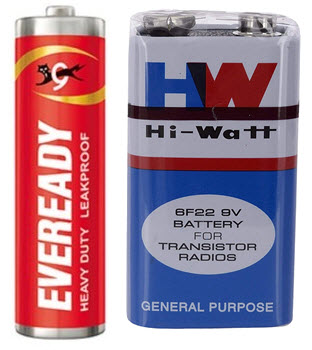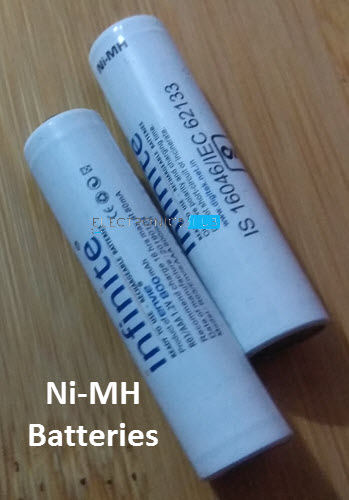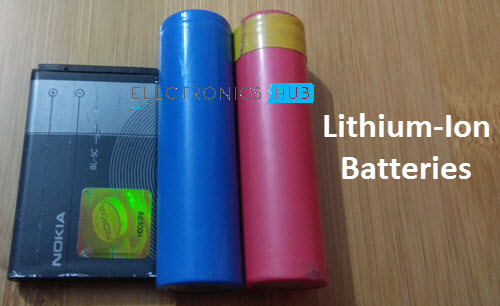Introduction
Whether you are an Electrical Engineer or not, you might have come across at least a couple of different types of batteries in your life. Some of the common places where you use batteries are a wall clocks, alarms or smoke detectors, which uses small disposable batteries or cars, trucks or motor cycles, which uses relatively large rechargeable batteries. Batteries have become a very important source of energy in the last decade or so. Even before that, they were an integral part of our lives in powering several portable devices like transistor radios, Walkman, handheld games, cameras etc. But with the development in advanced smart phones, tablets, laptops, solar energy and electric vehicles, the research into powerful batteries that can last longer and can deliver the necessary energy has been at its peak. As a matter of fact, the 2019 Nobel Prize in Chemistry has been awarded to three scientists John B. Goodenough, M. Stanley Whittingham and Akira Yoshino for the development of lithium-ion batteries.
What is a Battery?
A Battery is a chemical device that stores electrical energy in the form of chemicals and by means of electrochemical reaction, it converts the stored chemical energy into direct current (DC) electric energy. Alessandro Volta, an Italian Physicist, invented the first battery in 1800. The electrochemical reaction in a battery involves transfer of electrons from one material to another (called electrodes) through an electric current.
Cell and Battery
Even though the term battery is often used, the basic electrochemical unit responsible for the actual storage of energy is called a Cell. A Cell, as just mentioned, is the fundamental electrochemical unit that is the source of electrical energy produced by conversion of chemical energy. In its basic form, a cell typically contains three main components: two electrodes and electrolyte and also consists of terminals, separator and a container. Speaking of electrodes, there are two types of electrodes called the Anode and the Cathode. The Anode is the negative electrode (also called the Fuel Electrode or the Reducing Electrode). It loses electrons to the external circuit and in the electrochemical reaction, it gets oxidized. Cathode on the other hand, is the positive electrode (also called the Oxidizing Electrode). It accepts electrons from the eternal circuit and in the electrochemical reaction, it gets reduced. Hence, the energy conversion in a battery is due to electrochemical oxidation-reduction reaction. The third important component of a cell is the electrolyte. An electrolyte acts as medium for transfer of charge in the form of ions between the two electrodes. Hence, the electrolyte is sometime referred to as Ionic Conductor. An important point to be noted here that the electrolyte is not electrically conductive but just have ionic conductivity. A battery often consists of one or more “cells” that are electrically connected in either a series or parallel configuration to provide the necessary voltage and current levels.
Different Types of Batteries
Basically, all the electrochemical cells and batteries are classified into two types:
Primary (non-rechargeable) Secondary (rechargeable)
Even though there are several other classifications within these two types of batteries, these two are the basic types. Simply speaking, Primary Batteries are non-rechargeable batteries i.e., they cannot be recharged electrically while the Secondary Batteries are rechargeable batteries i.e., they can be recharged electrically.
Primary Batteries
A Primary Battery is one of the simple and convenient sources of power for several portable electronic and electrical devices like lights, cameras, watches, toys, radios etc. As they cannot be recharged electrically, they are of “use it and when discharged, discard it” type. Usually, primary batteries are inexpensive, light weight, small and very convenient to use with relatively no or less maintenance. Majority of the primary batteries that are used in domestic applications are single cell type and usually come in cylindrical configuration (although, it is very easy to produce them in different shapes and sizes).
Common Primary Battery Types
Up until the 1970’s, Zinc anode-based batteries were the predominant primary battery types. During the 1940’s, the World War II and after the war, Zinc – Carbon based batteries and they have an average capacity of 50 Wh / kg. Most significant development in the battery technology took place during the 1970 – 1990 period. It is during this time, the famous Zinc / Alkaline Manganese Dioxide batteries were developed and they slowly replaced the older Zinc – Carbon types as the main primary battery.
Zinc – Mercuric Oxide and Cadmium – Mercuric Oxide batteries were also used during this period but due to the environmental concerns with respect to the usage of Mercury, these battery types slowly phased out. It is during this period, where the development of batteries with Lithium as active anode material has been started and is considered a major accomplishment due to the high specific energy and longer shelf life of Lithium batteries over traditional Zinc batteries. Lithium batteries are manufactured as button and coin cell for a specific range of applications (like watches, memory backup, etc.) while larger cylindrical type batteries are also available. The following table shows different types of primary batteries along with their characteristics and applications.
Secondary Batteries
A Secondary Battery is also called as Rechargeable Battery as they can be electrically recharged after discharge. The chemical status of the electrochemical cells can be “recharged” to their original status by passing a current through the cells in the opposite direction of their discharge. Basically, secondary batteries can be used in two ways:
In the first category of applications, the secondary batteries are essentially used as energy storage devices where they are electrically connected to a main energy source and also charged by it and also supplying energy when required. Examples of such applications are Hybrid Electric Vehicles (HEV), Uninterrupted Power Supplies (UPS), etc. The second category of applications of secondary batteries are those applications where the battery is used and discharged as a primary battery. Once it is completely discharged (or almost completely discharged), instead of discarding it, the battery is recharged with an appropriate charging mechanism. Examples of such applications are all the modern portable electronics like mobiles, laptops, electric vehicles, etc.
Energy Density of secondary batterie are relatively lower than that of primary batteries but have other good characteristics like high power density, flat discharge curves, high discharge rate, low temperature performance.
Common Secondary Battery Types
Two of the oldest batteries are in fact secondary batteries called the Lead – Acid Batteries, which were developed in late 1850’s and Nickel – Cadmium Batteries, which were developed in early 1900’s. Until recent times, there are only two types of secondary batteries. The first and the most commonly used rechargeable batteries are called Lead – Acid Batteries. They are based on the Lead – Lead Dioxide (Pb – PbO2) electrochemical couple. The electrolyte used in these types of batteries is the very common Sulfuric Acid. The second type of the rechargeable batteries are called Nickel – Cadmium Batteries. They are based on Nickel Oxyhydroxide (Nickel Oxide) as the positive electrode and Cadmium metal based negative electrode. Coming to the electrolyte, an alkaline solution of Potassium Hydroxide is used. In the recent decades, two new types of rechargeable batteries have emerged. They are the Nickel – Metal Hydride Battery and the Lithium – Ion Battery. Of these two, the lithium – ion battery came out to be a game changer and became commercially superior with its high specific energy and energy density figures (150 Wh / kg and 400 Wh / L). There are some other types of Secondary Batteries but the four major types are:
Lead – Acid Batteries Nickel – Cadmium Batteries Nickel – Metal Hydride Batteries Lithium – Ion Batteries
Let us now briefly see about these battery types individually.
Lead – Acid Batteries
The lead-acid batteries are by far the most popular and most used rechargeable batteries. They have been a successful product for more than a century. Lead-acid batteries are available in several different configurations like small sealed cells with capacity of 1 Ah to large cells with capacity of 12,000 Ah. One of the major applications od lead-acid batteries are in the automotive industry as they are primarily used as SLI Batteries (Starting, Lighting and Ignition). Other applications of lead-acid batteries include energy storage, emergency power, electric vehicles (even hybrid vehicles), communication systems, emergency lighting systems, etc. The wide range of applications of lead-acid batteries are a result of its wide voltage ranges, different shapes and sizes, low cost and relatively easy maintenance. When compared to other secondary battery technologies, lead-acid batteries are the least expensive option for any application and provide very good performance. Electrical efficiency of lead-acid batteries is between 75 to 80%. This efficiency value them suitable for energy storage (Uninterrupted Power Supplies – UPS) and electric vehicles.
Nickel – Cadmium Batteries
The Nickel – Cadmium Batteries or simply Ni-Cd Batteries are one of the oldest battery types available today along with the lead-acid batteries. They have a very long life and are very reliable and sturdy.
One of the main advantages of Ni-Cd Batteries is that they can be subjected to high discharge rates and they can be operated over a wide range of temperatures. Also, the shelf life of Ni-Cd batteries is very long. The cost of these batteries is higher that lead-acid batteries on per Watt-hour basic but it is less that other type of alkaline batteries. As mentioned earlier, the Ni-Cd batteries use Nickel Oxyhydroxide (NiOOH) as Cathode and Cadmium metal (Cd) as anode. Typical consumer grade batteries come with an on-line voltage of 1.2V. In industrial applications, Ni-Cd are just second to lead-acid batteries due to their low temperature performances, flat discharge voltage, long life, low maintenance and excellent reliability. Unfortunately, there is one major characteristic of Ni-Cd batteries called the “memory effect”, which is their only disadvantage. When Ni-Cd cells are discharged partially and then recharged, they lose their capacity progressively i.e., cycle-by-cycle. “Conditioning” is the process where the lost capacity of the batteries can be restored. In this process, the cells are completely discharged to zero volts and then fully recharged.
Nickel – Metal Hydride Batteries
These are relatively new type of batteries are an extended version of Nickel – Hydrogen Electrode Batteries, which were exclusively used in aerospace applications (satellites). The positive electrode is the Nickel Oxyhydroxide (NiOOH) while the negative electrode of the cell is a metal alloy, where hydrogen is stored reversibly.
During charge, the metal alloy absorbs the hydrogen to form metal hydride and while discharge, the metal hydride loses hydrogen. One main advantage of Nickel-metal hydride batteries over Ni-Cd batterie its higher specific energy and energy density. Sealed Nickel-metal hydride batteries are available commercially as small cylindrical cells and are used in portable electronics.
Lithium – Ion Batteries
The emergence of lithium-ion batteries in the last couple of decades has been quite phenomenal. More than 50% of the consumer market has adopted the use of lithium-ion batteries. Particularly, laptops, mobile phones, cameras, etc. are the largest applications of lithium-ion batteries.
Lithium-ion batteries have significantly high energy density, high specific energy and longer cycle life. Other main advantages of lithium-ion batteries are slow self-discharge rate and wide range of operating temperatures.
Battery Applications
In the last few decades, the usage of small sealed batteries in consumer applications has been exponential. Primary or rechargeable batteries in small form factor are being used in a huge number of appliances. Some of them are mentioned below.
Portable Electronic Devices: Watches, Cameras, Mobile Phones, Laptops, Camcorders, Calculators, testing equipment (Multimeters). Entertainment: Radios, MP3 players, CD Players, all infrared remote controls, toys, games, keyboards. Household: Clocks, Alarms, Smoke Detectors, Flash lights, UPS, Emergency lights, tooth brushes, hair trimmers and shavers, Blood Pressure Monitors, Hearing Aids, pacemakers, portable power tools (drills, screw driver).
How to Choose a Battery?
Selecting a battery for your application can be dialed down to just two characteristics: Performance and Cost. But if we dig a little bit deeper, then the following are determining factors in choosing the right battery for your application.
Primary or Secondary Energy or Power Shelf Life Energy Efficiency and Recharge Rate Battery Life Battery Temperature
Conclusion
This was a brief introduction to Battery, Different Types of Batteries, Primary and Secondary Batteries, Rechargeable and Non-Rechargeable Batteries and also few common applications of each type of battery. Comment * Name * Email * Website
Δ









![]()